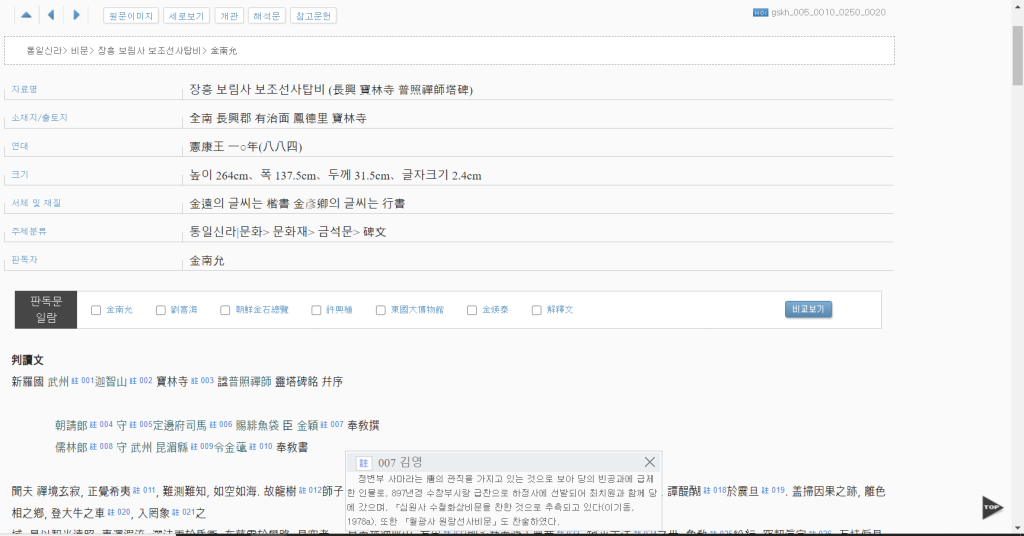This year, scholars and students across the globe have been forced to conduct research and gather materials for their projects and classes through the internet. Luckily for the field of Korean Studies, a huge amount of primary and secondary source material is available online, much of it for free. A concerted effort by the Korean government to promote Korean history and culture through digital means has produced national databases and portals that allow any interested party to browse premodern texts, objects, and sites from the comfort of their own homes. As a PhD candidate working with medieval Buddhist subjects, I have found these databases valuable – to varying degrees – for my own work. Here I will review my experience with the meta-search engine Korean History On-Line (Han’guk yŏksa chonghap chŏngbo sisŭt’em) and the affiliated links that have proven useful for me. Though well known to the Korean studies community, these archives may be new and helpful for the many readers that are tangentially related to the field.
Under the direction of the National Institute of Korean History, Korean History On-Line is meant to be a one-stop shop for the many digital manifestations of premodern Korean history that have been developed over the past 30 years. It aggregates the data contributed by 29 academic and government organizations such as the National Library of Korea, the National Museum of Korea, the Academy of Korean Studies, the Kyujanggak Institute of Korean Studies, etc. to provide a more holistic approach to Korean history.

Korean History On-Line landing page.
Given the great variety of material and the formidable time span covered, navigating the site to find exactly what you want requires a bit of patience and luck. Upon entering the site, one is confronted with a menu of various mediums of historical documents, materials, and scholarship. Categories such as ancient books and documents, modern translations of ancient texts, serials, timelines, maps, dictionaries, relics, and multi-media allow for ease of access if you know what kind of data are looking for. Other browsable categories include modern periodicals and records from the Chosŏn dynasty (1392-1910) by year, month, and day.
With tools like this, one would expect the search function to be a powerful feature as it should intelligently run through the many separate databases and produce search results based on relevance or popularity. It works well if your query is specific, like the title of a collection of poems or the name of an individual scholar. But if your search term is broad, like Koryŏsa 高麗史 (History of Koryŏ) or overly specific, like Changhŭng Porimsa Pojosŏnsa Changsŏngt’appimun 長興 寶林寺 普照禪師 彰聖塔碑文 (Stele Inscription of Pojo Ch’ejing at Porim-sa, in Changhŭng) then you are likely to get thousands of hits or none at all.

17,586 search results for Koryŏsa 高麗史.
Though this feature leaves much to be desired, the greatest benefit of using this meta-search tool is occasionally finding exactly what you need and much more. In the case of the stele inscription of the Sŏn monk Pojo, an edited query directed me to a subsidiary site where I was able to see the full text of the stele in the original hancha 漢字 (a set of Sinitic characters used in written Korean language), an annotated version of the text, a translation into modern Korean, as well as a high-resolution image of a rubbing of the stele (see the featured image at the top of the page).

Annotated original text of the stele inscription of the Sŏn monk Pojo.
These affiliated databases are immensely useful on their own and often have much more intuitive search tools than Korean History On-Line. The one I query the most for textual primary sources is DB of Korean Classics (Han’guk kojŏn chong’hap tibi). A trusted website for high quality images of visual and material culture is that of the National Museum of Korea. Lastly, though this one is behind a paywall, Korean History & Culture Research Database (Han’guk yŏksa munhwa chosa charyo teit’ŏbeisŭ) is an online repository of hard to access excavation reports of archaeological sites on the Korean peninsula.
In addition to these sites, three of the most commonly featured online resources for Koreanists are DBPia, KISS (Korean Studies Information Service System), and RISS (Research Information Sharing Service). They each host millions of full-text journal articles and dissertations as well as thousands of references and e-books. Although these are subscription services, they are commonly available through university libraries.
Since most of these sites are mainly presented in Korean, most scholars working in East Asian studies will find DB of Korean Classics the easiest to navigate and the most useful. This is because it is a database primarily of original texts and text images of thousands of premodern Korean sources that were written using hancha which is more or less accessible for those who can read Classical Chinese. The digitization of such a staggering amount of premodern texts attests to the Korean government’s investment in the online dissemination of Korean history. What remains to be seen, however, is what scholars and students can do with all this data and how it can change the way humanists conduct and present their research.
In a future piece, I will review a collaborative digital project run by the Digital Humanities Laboratory at the Academy of Korean Studies that delineates the potential of digital humanities at the present moment.

Thank you for sharing thhis